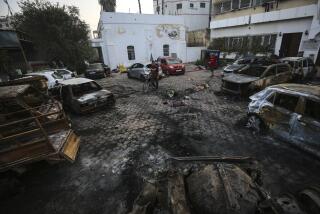Media judgment, like Flight 370, has vanished
- Share via
Rush Limbaugh is right on this one. The reporting on Malaysia Airlines Flight 370, which disappeared March 8, has turned into a spectacle — not the good kind.
It’s all “such a show,” Limbaugh told his listeners Monday. “We’ve got anchors and anchorettes who don’t know beans about even why an airplane flies. They couldn’t explain the concept of air pressure differential or lift to you if their jobs depended on it.”
Actually it’s even worse than “such a show”: The lack of any real information has pushed television news to new levels of unintentional self-parody. Commentators have used desktop model planes as props. Aviation experts seem mostly engaged in finding newer and pithier ways to say “I don’t have the faintest idea.”
Meanwhile, reporters everywhere seem to have taken the view that no theory is too cuckoo for primetime. On Anderson Cooper’s “AC 360,” which is so consumed with the story it might as well change its name to “AC Flight 370,” CNN’s Tom Foreman (strutting around on a veritable playground of a digital interactive map) delved into what he called the “very popular” theory that Flight 370 went “into stealth mode by flying in the radar shadow of another jet.”
Of course, what’s made this scenario popular on social media that it’s outlandish almost to the point of hilarity. And therein lies much of the problem. Social media, when it’s not functioning as a “you are there” primary source (think Tahrir Square) can be little more than a morass. On Twitter, Rupert Murdoch has been pushing terrorism theories since the beginning, tweeting on March 9 that the incident “confirms jihadists turning to make trouble for China,” and on Friday that the plane was “perhaps in Northern Pakistan, like Bin Laden.”
A few days later, rock musician and noted recovery mission specialist Courtney Love tweeted a photo of a body of water with arrows pointing to what she believed were oil slicks and metal wreckage. It turns out Love is among millions who are looking for the plane via the satellite map website Tomnod, which now entices people to join its community of searchers by asking if they’d prefer to seek out images of wreckage, oil slicks or rafts.
And even though her theory had been floated and ruled out by the time of her tweet, Love took it in stride. “I figured I’d do my part,” she told a reporter.
We should all be such good citizens! Because in this era of crowdsourcing, there’s nothing a trained professional can do that a mob of Google Earth users can’t do from the comfort of their sofas. You’re in good hands when Facebookers everywhere go on hiatus from their cat photos and Rumi quotations and take to posting theories about transponders and secret terrorist organizations.
Besides, given the Malaysian government’s record of retracting information just as soon as it’s released, isn’t it entirely possible that Love and Murdoch are just as likely to solve the mystery as anyone?
No. No one will. At least probably not for a long time. Even plane crashes that happen right before our eyes can take years to fully investigate. A situation like this one, in which there’s barely a “who, what and when,” much less a “where and why,” defies quick answers. It asks us not only to be patient but to accept the possibility that we may never know what happened. And for a culture that’s not only addicted to information but expects to have its questions answered instantly, that’s intolerable.
So we remain glued to the saga of Flight 370, filling the gaps in our understanding the same way the television networks fill their airtime, by spreading crazy theories, speculating about tiny blobs on satellite images and just generally pretending we know what we’re talking about when we obviously have no clue. We can’t get enough. Precisely because there isn’t enough.
As the TV correspondents play with their model planes and magic maps, there’s another, significantly bigger news story out there: Russian President Vladimir Putin’s takeover of Crimea. For all that coverage, Ukraine’s crisis still seems overshadowed in many outlets by this invisible plane. But then, it’s more Tolstoy than “Twilight Zone.” It can’t possibly compete. Unless those talking heads on cable news can get out some toy soldiers.
[email protected] Twitter: @meghan_daum
More to Read
A cure for the common opinion
Get thought-provoking perspectives with our weekly newsletter.
You may occasionally receive promotional content from the Los Angeles Times.











